Recent Water Damage Posts
Laundry Room Water Damage: 7 Amazing Tips To Avoid Damage
10/28/2024 (Permalink)
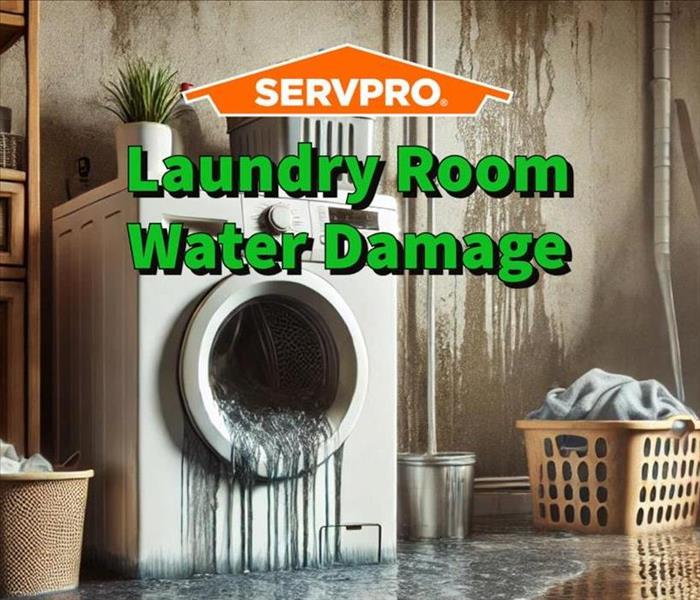 Our professionals are available 24/7 to help combat water damage!
Our professionals are available 24/7 to help combat water damage!
This detailed guide provides expert advice on managing and preventing water damage in your laundry room, keeping your home safe and secure.
Laundry rooms can be a hidden hotspot for water damage in your home. Multiple water sources—washing machines, pipes, and drainage systems—are in close proximity, so any malfunction can lead to significant issues.
In this post, we'll explore common causes of laundry room water damage, offer practical prevention tips, and show how SERVPRO® can help restore your property quickly and efficiently. We'll also share a real-life scenario from Winder, Georgia, demonstrating SERVPRO's quick response and restoration expertise.
Common Causes of Laundry Room Water Damage
Laundry room water damage often results from overlooked problems. Here are some of the most frequent causes:
- Washing Machine Leaks: Faulty hoses, overloading, or aging machines are all culprits of washing machine leaks. These leaks can cause significant water damage, especially when left unattended.
- Drainage Issues: A clogged or poorly installed drain can back up and flood your laundry room. Lint buildup or improper maintenance often causes these blockages.
- Burst or Leaking Pipes: Water supply lines to your washer or nearby pipes may corrode, crack, or burst, releasing a significant amount of water into your home.
- Improper Ventilation: Poor ventilation in your laundry room may lead to condensation buildup, which can eventually cause water damage to walls, ceilings, and flooring.
By understanding these familiar sources of water damage, you can take proactive steps to mitigate risk in your laundry room.
How Can Laundry Room Water Damage Impact Your Home?
Laundry room water damage can lead to far-reaching consequences if not addressed quickly:
- Structural Damage: Constant exposure to water weakens drywall, flooring, and structural components.
- Mold Growth: Excess moisture creates the perfect environment for mold growth, which can spread quickly.
- Increased Utility Costs: Water leaks or improper appliance installation can result in higher water bills and inefficient washing machine operation.
To avoid these risks, it's essential to identify and resolve potential water damage issues before they escalate.
Tips to Prevent Laundry Room Water Damage
While water damage can seem inevitable, taking these proactive steps can significantly reduce your risk:
- Inspect Washing Machine Hoses: Check hoses regularly for wear and tear. Replace them every five years or if there are any visible signs of deterioration.
- Use a Drain Pan: Place a drain pan under your washing machine to catch small leaks. This simple addition can prevent water from reaching the floor and causing damage.
- Clean the Drain Regularly: Clean your laundry room drain periodically to ensure it is free from blockages and help prevent drainage issues.
- Check for Leaks: Regularly inspect all pipes and fittings for any signs of leaks. If you notice rust, water spots, or pooling water, address the issue immediately to prevent further damage.
- Upgrade to Flood-Stop Systems: Consider installing an automatic shutoff system that detects water leaks and shuts off the water supply to your washing machine.
- Ensure Proper Ventilation: Adequate ventilation in your laundry room helps prevent excess moisture buildup, reducing the risk of water damage and mold.
- Water Alarms: Install water leak detectors in your laundry room to detect leaks early. These devices will alert you to leaks before they become more significant problems.
A Laundry Room Water Damage Emergency in Winder, Georgia
Last month, SERVPRO responded to an emergency water damage call in Winder, Georgia. A homeowner had noticed a small leak under their washing machine, but unfortunately, they didn't realize the extent of the problem until it was too late. Over the course of several days, water had seeped into the walls, causing damage to the drywall and flooring. The homeowner quickly called SERVPRO® for assistance.
Our team arrived on-site and conducted a thorough assessment of the damage. We discovered the water had penetrated deeper into the flooring and subfloor than initially expected. To resolve the issue, we developed a comprehensive action plan, which included:
- Water Extraction: Our priority was to remove all standing water using high-powered extraction equipment. This minimized further water intrusion and mitigated secondary damage.
- Drying and Dehumidification: Next, we used advanced drying technology, such as industrial fans and dehumidifiers, to ensure all moisture was thoroughly eliminated from the affected areas. This step was crucial in preventing mold growth within 24-48 hours in a damp environment.
- Structural Repairs: Our team carefully removed damaged drywall and flooring and replaced them with new materials. The restoration process ensured the homeowner's laundry room was restored to its preloss condition.
- Ongoing Monitoring: We also set up moisture monitoring devices to check the moisture levels over the following days, ensuring that all water was removed and that no mold or additional structural issues arose.
This scenario in Winder, Georgia, highlights the importance of quick action when dealing with laundry room water damage. Thanks to SERVPRO®'s expertise, the homeowner's property was fully restored, and future risks of water damage were minimized.
What to Do When You Experience Laundry Room Water Damage
When you first notice signs of water damage in your laundry room, time is of the essence. Here are some critical steps to take:
- Shut Off the Water: If possible, turn off the water supply to the washing machine or the affected pipe. This can help reduce the amount of water flooding the room.
- Remove Wet Items: Remove wet clothes, rugs, or furniture from the laundry room to prevent additional damage.
- Contact SERVPRO: The quicker you call in the professionals, the better. SERVPRO's team of experts will promptly arrive on-site to assess the damage and begin restoration.
Wrapping Up
SERVPRO's reputation for handling water damage restoration is built on our commitment to fast, efficient, and comprehensive service. We understand the urgency of water damage situations, and our highly trained technicians are equipped with advanced tools to ensure your property is restored to its pre-damage condition.
SERVPRO is your go-to solution for water damage restoration, from laundry room floods to larger-scale issues. With our expertise and cutting-edge techniques, you can rest assured that your home will be in good hands. Remember, the key to minimizing water damage is prevention. By following the steps outlined above, you can significantly reduce your risk of laundry room water damage and protect your home from future incidents.
Moisture Mapping: 7 Tips for Effective Damage Restoration
5/27/2024 (Permalink)
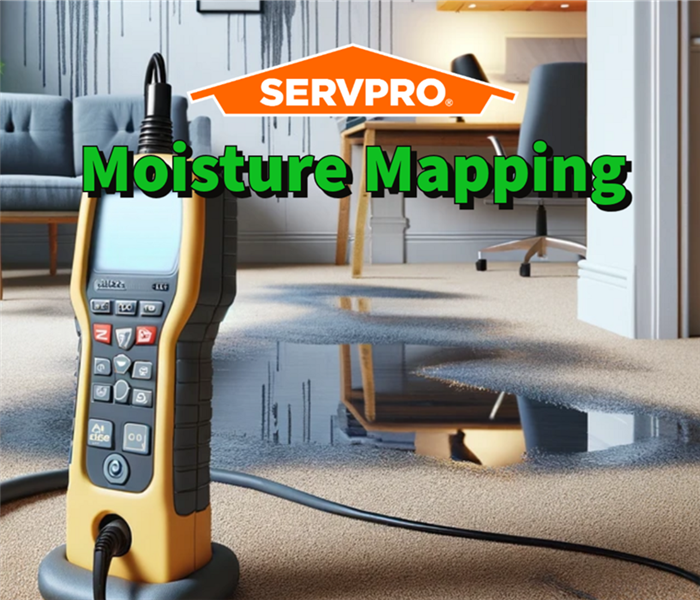 The professionals at SERVPRO are experts in moisture mapping!
The professionals at SERVPRO are experts in moisture mapping!
Expert insights and practical steps to safeguard your property from hidden moisture damage.
Water damage can be a daunting challenge for property owners, often hiding in places that aren't immediately visible. Moisture mapping is essential in restoration, ensuring that all moisture is detected and addressed to prevent further damage. This blog post will explore the importance of moisture mapping, offer practical tips for utilizing this technology, and highlight how SERVPRO® expertise can be invaluable in managing moisture-related issues.
What is moisture mapping, and why is it important?
Moisture mapping involves using specialized equipment and techniques to detect and map out moisture areas within a property. This process is essential because:
- Prevents Further Damage: Identifying hidden moisture as soon as possible prevents secondary damage, such as mold growth and structural weakening.
- Ensures Comprehensive Restoration: Complete moisture detection ensures that all affected areas are addressed, leading to thorough and effective restoration.
- Speed Up Recovery: Efficient moisture detection and mapping accelerate the drying process, reducing downtime and restoration costs.
- Improves Accuracy: Advanced technology provides precise moisture readings, allowing for targeted and effective restoration efforts.
Common challenges in detecting moisture
Detecting moisture can be challenging due to various factors:
- Hidden Moisture: Moisture often seeps into hidden areas such as behind walls, under floors, and within insulation.
- Complex Building Structures: Large or complex buildings with multiple layers and materials can make moisture detection more difficult.
- Inaccurate Initial Assessments: Initial assessments may miss moisture areas without advanced technology, leading to incomplete restoration.
- Delayed Detection: Late moisture detection can lead to extensive damage, increasing restoration time and costs.
7 tips for effective moisture mapping
Ensuring effective moisture mapping involves using the right tools and techniques. Here are some practical steps to guide you through the process:
Use Specialized Equipment
Invest in specialized moisture detection equipment such as thermal imaging cameras, hygrometers, and moisture meters. These tools provide accurate and comprehensive moisture readings.
Conduct a Thorough Inspection
Perform a detailed inspection of the property, focusing on areas prone to moisture buildup, such as basements, attics, and behind walls. Use advanced equipment to detect hidden moisture.
Document Moisture Levels
Keep detailed records of moisture levels in different areas of the property. Documenting moisture readings helps track progress and ensures all areas are addressed.
Develop a Moisture Map
Create a moisture map of the property, highlighting areas with detected moisture. This visual representation helps guide the restoration process and ensures that no area is overlooked.
Implement Targeted Drying Techniques
Use targeted drying techniques based on the moisture map. Focus on high-moisture areas first and use appropriate drying equipment such as dehumidifiers and air movers.
Monitor Progress
Regularly monitor moisture levels throughout the restoration process. Adjust drying techniques as needed to ensure complete moisture removal.
Work with Professionals
Hire a professional restoration company, like SERVPRO, specializing in moisture mapping and water damage restoration. Professionals have the expertise and equipment to ensure thorough and effective restoration.
A recent moisture mapping success story in Winder, Georgia
In Winder, Georgia, SERVPRO was recently called to handle a challenging water damage situation in a commercial property. The property had suffered extensive water intrusion due to a broken pipe, and the business owner was concerned that hidden moisture would compromise the building's integrity and operations. This scenario highlights the importance of moisture mapping in comprehensive restoration.
Upon receiving the call, our SERVPRO team quickly mobilized to assess the situation. We conducted a thorough inspection using advanced moisture detection equipment. We identified several hidden areas of moisture that were not immediately visible. Our action plan included:
- Detailed Moisture Mapping: We created a comprehensive moisture map of the property, highlighting all affected areas, including hidden moisture behind walls and under floors.
- Targeted Drying Strategy: We developed a targeted drying strategy based on the moisture map, prioritizing high-moisture areas and using specialized drying equipment to ensure complete moisture removal.
- Continuous Monitoring: We monitored moisture levels throughout the restoration process, adjusting our techniques to ensure thorough drying.
- Comprehensive Restoration: After removing all moisture, we performed necessary repairs and restorations, including replacing damaged materials and restoring the property's operational areas.
This incident in Winder, Georgia, demonstrates the effectiveness of moisture mapping in property restoration. Our proactive approach and attention to detail not only addressed the immediate water damage but also ensured the long-term integrity and functionality of the commercial property.
What should you do when you suspect hidden moisture in your property?
If you suspect hidden moisture in your property, conduct a thorough inspection using advanced moisture detection equipment. Contact a professional restoration team, like SERVPRO, to assess the situation and develop a comprehensive moisture mapping and restoration plan. Document moisture levels and monitor progress to ensure complete moisture removal.
Wrapping up
SERVPRO's reputation in moisture mapping and water damage restoration is built on expertise, advanced technology, and skilled professionals. We understand the complexities of moisture detection and the critical role of comprehensive restoration. Our team is trained to handle all aspects of water damage, ensuring efficient and effective results.
SERVPRO for moisture mapping offers more than restoration services; it provides peace of mind and confidence in achieving a successful outcome. Our quick response, cutting-edge techniques, and customer-centric approach make us a trusted partner in navigating water damage challenges. With careful planning and the support of SERVPRO professionals, you can ensure thorough moisture detection and restoration, protecting your property from hidden damage.
Following these tips and relying on professional expertise can ensure effective moisture mapping and comprehensive restoration, minimizing damage and a swift recovery. Whether dealing with a minor water leak or extensive water damage, SERVPRO is here to help with advanced moisture mapping and restoration services.
5 Critical Signs of a Dishwasher Leak on Your Property
12/25/2023 (Permalink)
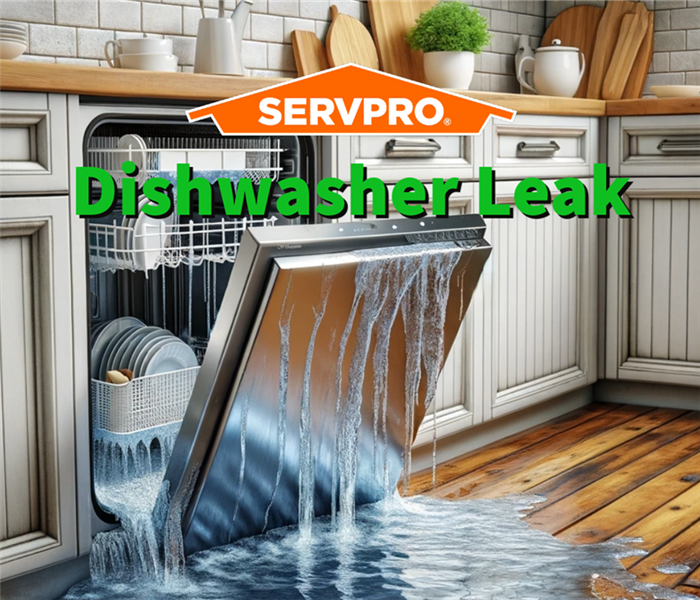 The professionals at SERPVRO are available 24/7 to help combat water damage after a dishwasher leak.
The professionals at SERPVRO are available 24/7 to help combat water damage after a dishwasher leak.
Let's delve into the indicators of a dishwasher leak so you can identify and address the issue before it escalates into a more significant problem.
In the complex world of property maintenance, understanding the subtleties of water damage is crucial. A common but often underestimated source of such damage is a dishwasher leak. These leaks can lead to significant structural damage and costly repairs if not addressed promptly.
This blog post aims to enlighten property owners about the common indications of a dishwasher leak and how the professionals at SERVPRO®, a leader in water damage restoration, can effectively recover and protect your property.
What are the signs of a dishwasher leak?
- Visible water pools or dampness around the dishwasher: One of the most apparent signs of a dishwasher leak is water around the base of the appliance. Pooling could indicate a loose or damaged hose, a faulty seal, or a crack in the unit.
- Unusual sounds during operation: A dishwasher making strange noises—such as dripping or splashing sounds—may suggest internal leaks.
- Musty odors or mold growth: Persistent musty odors or visible mold growth near the dishwasher are strong indicators of ongoing water leaks, creating a perfect mold environment.
- Warped or discolored flooring: Water seeping from a dishwasher can damage flooring, leading to warping, discoloration, or buckling, especially on wooden or laminate floors.
- Malfunctioning dishwasher: If your dishwasher is not operating as efficiently as it used to, it could be due to internal leaks affecting its performance.
What are the common causes of a dishwasher leak?
Dishwasher leaks can arise from various sources:
- Overloading or incorrect loading: Overloading the dishwasher or incorrectly placing dishes can prevent the door from sealing correctly, leading to leaks.
- Worn gaskets or seals: Over time, door gaskets and seals can wear out, allowing water to escape.
- Loose or damaged hoses: Hoses connecting the dishwasher to the water supply can become loose or damaged, causing leaks.
- Faulty valves or pumps: Malfunctioning valves or pumps can lead to water leakage within the dishwasher.
Tips to prevent dishwasher leaks
Preventive measures are crucial to avoiding dishwasher leaks:
- Regular maintenance: Inspect and maintain the dishwasher, especially the seals and hoses.
- Proper loading: Load the dishwasher according to the manufacturer's instructions to avoid blocking the spray arm or door.
- Prompt repairs: Address any signs of malfunction or wear and tear immediately to prevent further damage.
SERVPRO's expert intervention: A recent call from Winder, Georgia
When a commercial property in Winder, Georgia, experienced a significant dishwasher leak, the SERVPRO team was called upon for their expertise. The leak had caused extensive water damage to the kitchen area and adjacent rooms. Our team swiftly assessed the situation and implemented a comprehensive restoration plan. We salvaged the affected regions using advanced water extraction and drying techniques to prevent mold growth and further structural damage. This intervention is a testament to SERVPRO's commitment to rapid response and effective water damage restoration.
Why choose SERVPRO for water damage repairs?
When facing water damage, particularly from a dishwasher leak, choosing SERVPRO offers numerous advantages:
- Rapid response: SERVPRO professionals are available 24/7 to address water damage emergencies swiftly.
- Advanced technology: We use state-of-the-art water extraction, drying, and moisture detection equipment.
- Expertise and experience: Our team comprises skilled technicians trained in the latest water damage restoration techniques.
- Comprehensive services: SERVPRO handles all aspects of water damage recovery from the initial assessment to the final restoration.
- Customer satisfaction: Our focus is on ensuring customer satisfaction through quality service and effective communication.
Final Thoughts
Understanding the signs of a dishwasher leak and taking prompt action can significantly mitigate the damage to your property. SERVPRO is a leader in water damage restoration, offering rapid, reliable, and expert services. Whether it's a residential or commercial property, our team is equipped to handle any scale of water damage, ensuring your space is restored to its pre-damage condition. Trust SERVPRO of Barrow County for your water damage restoration needs; our top priorities are quality service and customer satisfaction.
Hidden Dangers of Foundation Leaks and The Top 3 Causes
7/31/2023 (Permalink)
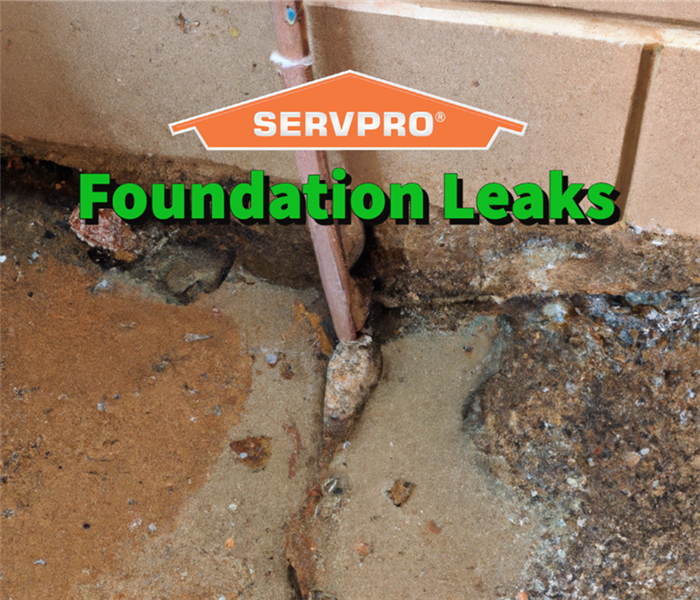 The professionals at SERVPRO are available 24/7 to help you combat water damage caused by a foundation leak.
The professionals at SERVPRO are available 24/7 to help you combat water damage caused by a foundation leak.
Foundation leaks can lead to severe water damage if left unchecked.
When protecting our homes, the foundation is often overlooked, yet it serves as the bedrock upon which our homes stand. Unfortunately, foundation leaks are a common issue residential properties face, and their consequences can be devastating.
This blog post will delve into the most common causes of foundation leaks and how they can lead to severe water damage. By understanding the risks, homeowners can proactively safeguard their properties. Moreover, we will shed light on why SERVPRO® should be the go-to choice for water damage restoration services, ensuring peace of mind in the face of adversity.
What are foundation leaks?
Foundation leaks refer to water infiltration through cracks, gaps, or faulty areas in a property's foundation. These leaks can occur due to various factors, such as aging infrastructure, poor construction practices, or shifts in the soil. Over time, the accumulated water can seep into the property's structure, leading to a range of issues that demand immediate attention.
Common causes of foundation leaks
- Soil settlement and shifting: As the soil beneath a property settles or experiences shifts, it exerts pressure on the foundation. This pressure can create cracks and openings, allowing water to infiltrate the property.
- Poor drainage systems: Inadequate or faulty drainage systems significantly contribute to foundation leaks. When rainwater is not efficiently directed away from the foundation, it can accumulate around the perimeter, exerting hydrostatic pressure on the structure and leading to leaks.
- Plumbing issues: Faulty plumbing—such as leaking pipes—can result in water seeping into the foundation. Even seemingly minor leaks can exacerbate over time, causing significant damage to the property's foundation and overall structural integrity.
The devastating consequences of foundation leaks
- Structural damage: Water intrusion weakens the foundation, compromising the stability and structural integrity of the property. Cracks may appear in walls, ceilings, and floors, rendering the structure unsafe.
- Mold and mildew growth: Excess moisture creates an ideal breeding ground for mold and mildew. Mold poses risks and contributes to further deterioration of the property.
- Damage to personal belongings: Water damage can ruin furniture, carpets, electronics, and sentimental items within the affected area. Salvaging these possessions becomes increasingly difficult the longer the water intrusion persists.
- Increased energy costs: Foundation leaks can compromise a property's insulation, leading to heat loss in winter and heat gain in summer. A foundation leak may strain heating and cooling systems, producing higher energy bills.
SERVPRO of Barrow County: your trusted partner for recovery from foundation leaks
- Expertise and experience: With decades of experience in the field, SERVPRO of Barrow County possesses the knowledge and skills to handle any water damage restoration project. Their technicians are certified and equipped with state-of-the-art tools to mitigate damage efficiently.
- Rapid response: SERVPRO of Barrow County understands the urgency of water damage situations. Their 24/7 emergency services ensure that a trained team will be on-site promptly, minimizing the extent of damage and reducing the potential for further complications.
- Comprehensive solutions: From initial assessment to the final stages of restoration, SERVPRO of Barrow County offers a wide range of services. These include water extraction, drying and dehumidification, mold remediation, and structural repairs, ensuring that every aspect of the restoration process is handled professionally and efficiently.
- Insurance coordination: Navigating insurance claims can be a daunting task, especially during times of distress. SERVPRO of Barrow County works closely with insurance companies, assisting homeowners in documenting the damage, providing necessary evidence, and streamlining the claims process.
In conclusion
Foundation leaks pose a significant threat to the integrity of residential properties, potentially leading to severe water damage and long-term consequences. By understanding the causes and recognizing the importance of immediate action, homeowners can protect their investments and ensure the safety of their loved ones.
When faced with water damage restoration needs, SERVPRO's expertise, rapid response, comprehensive solutions, and insurance coordination make them the top choice for homeowners seeking efficient and reliable water restoration services. Remember, early intervention is the key to minimizing the impact of foundation leaks and restoring your home to its former glory!
Successful Roof Leak Restoration & The #1 Prevention Tip
2/27/2023 (Permalink)
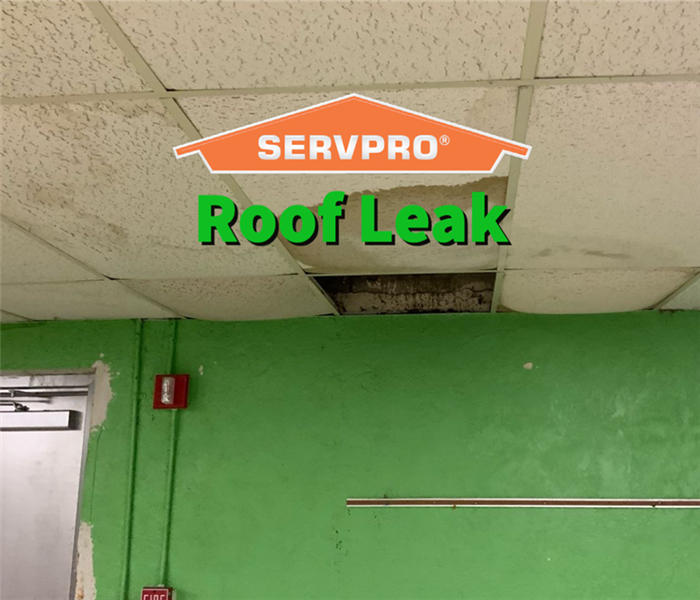 The professionals at SERVPRO are available 24/7 to help mitigate and restore roof leak damages!
The professionals at SERVPRO are available 24/7 to help mitigate and restore roof leak damages!
Water damage caused by a roof leak is a recurring emergency call for the professionals at SERVPRO of Barrow County.
Owning a property comes with many responsibilities, and roof leaks can be one of the most daunting. Water damage from roof leaks can cause severe structural problems if left unchecked, leading to costly repairs that property owners could have avoided with quick action in the first place.
However, identifying and restoring roof leaks can be a manageable task. With some basic knowledge and critical tips on assessing water damage sources, inspecting attic areas for signs of roof leakage, and repairing roof leakages, your roof will be restored in no time!
The professionals at SERVPRO understand that roof leak repairs are a time-sensitive priority for all property owners. Therefore, in this article, we will provide readers with the essential information they need to identify roof leakages quickly and repair them effectively. So let's get started!
What causes a roof to leak?
Roof leaks occur when roofing materials such as shingle layers, roofing felt, or flashing becomes broken or cracked, allowing water to seep in and cause damage. Various factors can cause roof leaks, such as severe weather conditions, improper roof construction or installation, age of the roof, and other environmental conditions. A roof leak can be hard to spot, so keep an eye out for signs of roof leakage, such as water stains and wet spots on ceilings, walls, or floors.
How do you inspect an attic area for roof leaks?
When inspecting the attic area for roof leaks, look for visible moisture on the underside of roofing materials; check for water stains or dark surface spots that may indicate a roof leak. Check the roof from interior and exterior points of view, as some roof leakages are only visible from one vantage point. If you still cannot pinpoint where the roof leak is coming from, use a flashlight to look for damaged or broken roofing materials. It is important to note that roof leaks can sometimes be small and difficult to detect, so look closely at all roof surfaces for any signs of water damage.
How do you repair a roof leak?
After identifying the roof leak, the next step is to start making repairs. Depending on the roof type, the roofing materials may need to be replaced or resealed with roof sealant. If you are comfortable making roof repairs, use roof patchwork kits—you can easily find these at most hardware stores. Make sure to apply roof sealant around the affected area before placing a roof patch over it to ensure adequate sealing of the roof leak. Seek professional help if the roof leak issue requires more extensive repair than the patch can provide—experienced roof restoration professionals can best handle more significant roof repairs.
Preventing roof leaks: our #1 tip
After your roof has been repaired, the next step is to take preventive measures to prevent roof leakage from occurring again. Regular roof inspections should be performed twice yearly to identify any signs of roof damage or wear and tear that may lead to roof leakages. Additionally, ensure that roofing surfaces are kept clean and free from debris, as this can reduce the chances of roof leaks.
How the professionals at SERVPRO of Barrow County restore roof leaks
When roof leaks occur, the roofing experts at SERVPRO of Barrow County can help. We specialize in roof restoration services designed to restore roof leakages quickly and efficiently. Our water damage and roofing team are trained and certified to handle all roof-related issues, ensuring your roof is secured against water damage. Whether you need a minor repair or a more significant roof restoration, our roofing professionals are here to help. We will follow the following steps to help restore roof leaks:
- Assess the roof to identify the source of water damage
- Remove excess water and dry the property using state-of-the-art restoration equipment
- Inspect the attic area for roof leakage and roof damage
- Repair the roof using roof patchwork kits or roof sealant
- Take preventive measures to prevent future roof leakages.
We understand that restoring a roof leak can be a daunting task, but our roofing professionals are here to help. With the proper knowledge and expertise, we can confidently repair your roof and protect your property from further damage.
Wrapping up
Today we discussed everything a property owner needs to know about roof leaks. In addition, we discussed how to identify, diagnose, and repair roof leaks and take preventive measures to prevent roof leakage from occurring again.
If you're dealing with roof leakages, the roofing experts at SERVPRO of Barrow County are here to help! With our roof restoration services, we can restore roof leaks quickly and efficiently. Contact us today to learn more about how we can help you repair your roof with confidence.
The Top 4 Causes of Basement Water Damage
9/26/2022 (Permalink)
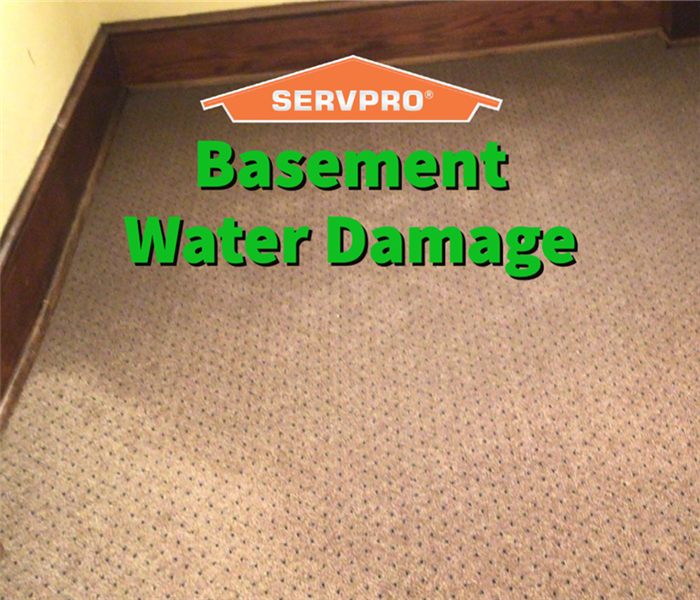 The professionals at SERVPRO are on-call to help combat basement water damage!
The professionals at SERVPRO are on-call to help combat basement water damage!
The professionals at SERVPRO of Barrow County never want you to combat basement water damage alone!
Many homeowners experience water damage at some point, and there are several reasons why it might occur. Although water damage is common, one of the most problematic places for water damage to occur is in a basement because it often goes undetected for a while.
The professionals at SERVPRO of Barrow County understand the headache that comes with basement water damage. Not only is it a hassle to clean up, but it can also lead to extensive damage if not taken care of quickly.
In this blog post, we will discuss the top four causes of basement water damage and how you can prevent it from occurring. We will also talk about steps you should take when your basement becomes flooded and how the professionals at SERVPRO of Barrow County can help restore your basement water damage.
If you are currently experiencing basement water damage, it's crucial to call the professionals at SERVPRO of Barrow County right away to help get your home back to normal. We offer comprehensive restoration services that will help you get your home back in order.
What is basement water damage?
Basement water damage is any water damage that occurs in the basement of a home. The professionals at SERVPRO know that basement water damage is a common problem for many homeowners, and there are several reasons why this might happen. Here are the top four causes of basement water damage jobs we have restored:
- Roof and gutter leaks
- Broken pipes
- Appliance leaks
- Improper grading and drainage
Roof and gutter leaks
We have seen a lot of basement water damage caused by roof and gutter leaks. When your roof leaks, water can run down the sides of your house and seep into your basement. The best way to prevent this from happening is to keep your gutters clean and clear of debris. It's also a good idea to have your roof regularly inspected to ensure that there are no leaks.
Broken pipes
Another common cause of basement water damage is broken pipes. Pipes can break for several reasons, including freezing temperatures and tree roots that have grown into the pipes. The best way to prevent your pipes from breaking is to have them regularly inspected and keep them insulated during winter.
Appliance leaks
Appliance leaks are another common cause of basement water damage. Leaks can occur in washing machines, dishwashers, water heaters, and other appliances. The best way to prevent appliance leaks is to have your appliances serviced regularly and check for leaks regularly.
Improper grading and drainage
Improper grading and drainage issues are the last common reason for basement water damage. Water can pool around your foundation and seep into your basement when your yard is not properly graded. The best way to prevent this from happening is to ensure that your yard is graded correctly and that your gutters are draining away from your property.
Steps to take after you find standing water in your basement
After you find water damage in your basement, the first thing you should do is contact a professional water restoration company. The company you hire should offer comprehensive water restoration services to help you get your basement back in order.
In addition to calling water damage professionals, there are a few steps you can take to help minimize the damage caused by basement water damage:
- Turn off the electricity to the basement
- Remove any furniture or items from the basement damaged by water
- Take pictures and videos of the damage for insurance purposes
- Move any valuable items to a higher level in your home
- Remove any carpets or rugs from the basement and dry them immediately
- Open up all of the windows and doors to allow air to circulate
- Consider installing a sump pump to prevent future damages
How SERVPRO of Barrow County can help with basement water damage
After you find basement water damage, you should call the professionals at SERVPRO of Barrow County right away to help get your home back to normal. We offer comprehensive restoration services that have helped hundreds of property owners.
Our basement water damage services include:
- Water extraction
- Drying and dehumidification
- Mold Remediation
- Structural drying
- Content cleaning
- Packout and storage of damaged belongings
- Insurance claim assistance
We understand the importance of timely basement water damage mitigation and will work quickly to get your basement dried out and your home back to normal. Contact SERVPRO of Barrow County today for all of your basement water restoration needs!
The 5 Dangers of Crawlspace Water Damage
8/22/2022 (Permalink)
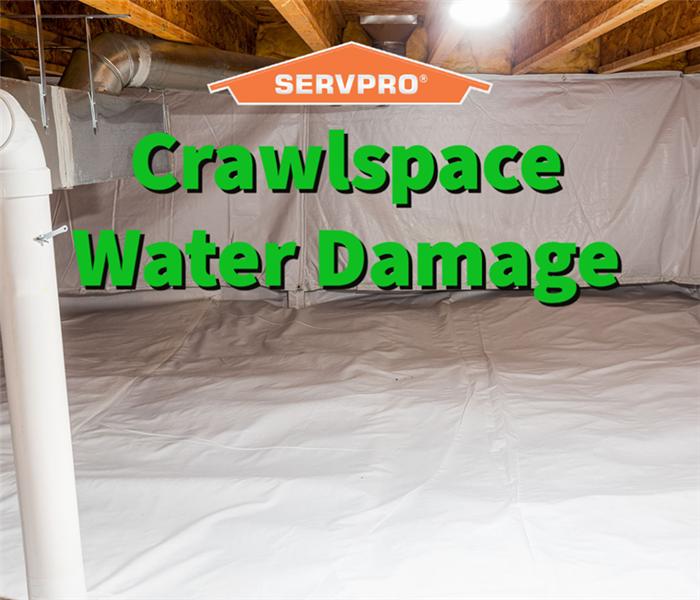 The professionals at SERVPRO are available 24/7 to combat water damage!
The professionals at SERVPRO are available 24/7 to combat water damage!
The nightmare of crawlspace water damage does not need to become a reality for your home.
The professionals at SERVPRO of Barrow County know that no one ever plans on their home sustaining water damage, but it can happen to anyone at any time. If your home does experience water damage, it's essential to take action as soon as possible to minimize the damage and prevent further problems.
We understand that the crawlspace is one of the most challenging areas of a home to keep dry. Unfortunately, crawlspaces are often forgotten until there's a problem, but they play an essential role in the overall health of your home. A properly functioning crawlspace helps to keep your home stable, support your HVAC system, and protect your home from moisture and pests.
Unfortunately, crawlspace water damage is a common problem in crawlspaces. Water can enter the crawlspace through cracks in the foundation, holes in the vapor barrier, or from heavy rains or flooding. Once water enters the crawlspace, it can quickly lead to severe problems.
What is a crawlspace?
A crawlspace is a small, unfinished space between the ground and the foundation of a home. Crawlspaces are typically about 3-4 feet high, making them difficult to access. They are used primarily for storage or to house HVAC equipment.
The five dangers of water damage in a crawlspace
- Structural Damage: Water can cause severe damage to the structural components of your home, including the foundation, floors, and walls.
- Mold and mildew growth: One of the most common problems associated with water damage is mold and mildew growth. Mold and mildew thrive in damp, dark environments like crawlspaces.
- Pest infestation: Pest infestation is another common problem associated with water damage. Pests love moisture, so a wet crawlspace is the perfect breeding ground for pests like termites, carpenter ants, and rodents.
- Air quality issues: When mold and mildew grow in a crawlspace, it can lead to air quality problems inside your home. Mold spores can travel through the vents and into your living space, causing poor air quality.
- Damage to HVAC systems: Excess moisture in a crawlspace can damage your HVAC system. The condensation from a wet crawlspace can cause rust and corrosion, leading to expensive repairs or replacement.
Preventing crawlspace water damage
Now that you're aware of the dangers of water damage in a crawlspace, you're probably wondering how to prevent it.
There are a few different ways to prevent crawlspace water:
- Install a vapor barrier: A vapor barrier is a heavy-duty plastic sheet placed on the ground of a crawlspace. It helps to prevent moisture from seeping into the crawlspace from the ground.
- Improve drainage: Make sure your gutters are clean and in good repair and that they are directing water away from your foundation. You may also want to install a French drain around the perimeter of your foundation to help with drainage.
- Repair cracks and holes: Inspect your foundation regularly for cracks or holes. If you find any, seal them with concrete or epoxy.
- Control the humidity: Install a dehumidifier in your crawlspace to help control the moisture level.
- Check for leaks: Check your plumbing and HVAC systems regularly for leaks. Even a tiny leak can cause a lot of damage over time.
How SERVPRO of Barrow County can help you with crawlspace water damage
As you have learned, crawlspace water damage is a severe problem that should be professionally addressed as soon as possible. If you suspect water damage in your crawlspace, you must call a professional restoration company like SERVPRO of Barrow County.
SERVPRO of Barrow County has the training, experience, and equipment to handle all your water damage restoration needs. We will work quickly to assess the extent of the damage and develop a plan to restore your crawlspace.
We understand that dealing with water damage can be stressful, so we will work with you every step to ensure you are happy with the results. Contact SERVPRO of Barrow County today to learn more about our water damage restoration services or to schedule an inspection!
Water Heater Leak: The 3 Most Common Causes
7/18/2022 (Permalink)
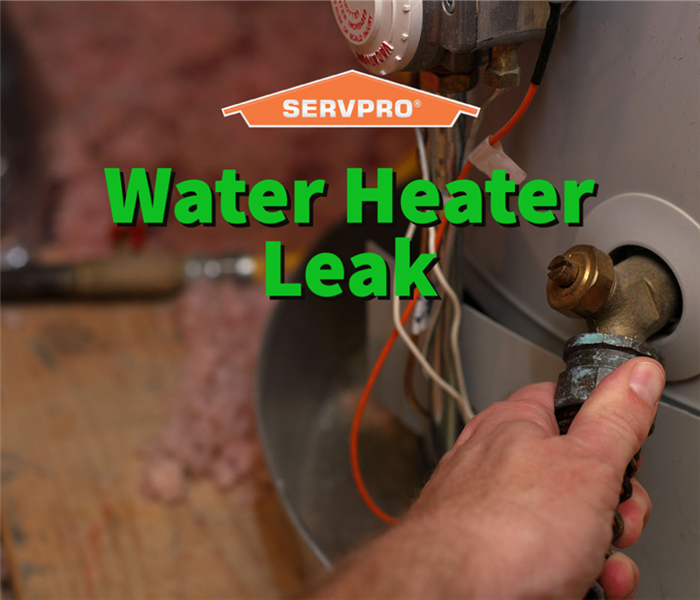 The professionals at SERVPRO are available 24/7 to restore any size water damage disaster!
The professionals at SERVPRO are available 24/7 to restore any size water damage disaster!
A water heater leak can release hundreds of gallons of water into your home and cause extensive water damage.
Water heaters are essential to any home; they provide hot water for baths, showers, dishwashing, and laundry. But like all appliances, water heaters can break down, and when they do, they can cause water damage to your home.
The professionals at SERVPRO of Barrow County have recently seen an influx of water heater leaks and water damage claims. Therefore, we have compiled a list of the three most common causes of water heater leaks so that you can be informed and know where to check for leaks.
What is a water heater leak?
A water heater leak is a water leak that originates from the water heater. Water heaters have various valves and pipes that can develop leaks over time. When one of these components fails, water can start to leak from the water heater, often causing extensive water damage to the surrounding area.
The three most common causes of water heater leaks
1) Faulty pressure relief valve
A faulty pressure relief valve is one of the most common causes of water heater leaks. The pressure relief valve is a safety device designed to release water and pressure from the tank if it gets too high. Over time, the valve can become corroded or damaged, causing it to constantly stick in the open position and release water. If you notice water leaking from the side of your water heater, the pressure relief valve likely is to blame.
2) Corroded water tank
Another common cause of water heater leaks is a corroded water tank. Over time, the water in the tank can become corrosive and eat away at the tank itself, causing it to develop leaks. Corrosion is more common in older water heaters but can happen to any water heater if the water is not maintained correctly. If you notice water leaking from the bottom of your water heater, it is likely that the tank is corroded and needs replacing.
3) Leaky pipes
The third most common cause of water heater leaks is leaky pipes. Water heaters consist of various pipes that can develop leaks over time. The most common type of leaky pipe is the drain line, which connects the water heater to the sewer line. If this pipe becomes corroded or damaged, water can leak from the water heater. Therefore, if you notice water leaking from the water heater, it is likely that one of the pipes is to blame.
What to do if you find water leaking from your water heater?
If you find water leaking from your water heater, it is essential to take action immediately to prevent further water damage. The first thing you should do is turn off the water supply to the water heater. You can turn off the water supply by turning the water valves off at the water heater or the main water supply line. Once the water is off, you should call a professional water damage restoration company to come and assess the situation. The right team of professionals will work quickly to repair the water damage and get your home back to normal.
How the professionals at SERVPRO of Barrow County can help restore your water heater leak
If you have water damage due to a water heater leak, the professionals at SERVPRO of Barrow County can help. We have extensive experience repairing water damage and will work quickly to get your home back to normal.
We will first assess the situation and determine the cause of the water leak. Once we know what is causing the leak, we will work quickly to repair the damage and prevent further water damage. We will then work to restore your property to its original condition.
If you have a water heater leak, don't hesitate to call the professionals at SERVPRO of Barrow County. We are here to help, and our IICRC-certified professionals will work quickly to get your home back to normal.
Wrapping up
We hope that you found this blog post on water heater leaks helpful. As you can see, water heater leaks can cause extensive water damage to your home, so it is essential to take action immediately if you notice water leaking from your water heater. The best actionable step is to call SERVPRO.
SERVPRO of Barrow County are experts in repairing water damage and will work quickly to get your home back to normal. When you choose to hire us, we will:
- Assess the situation and determine the cause of the water leak
- Work quickly to repair the damage and prevent further water damage
- Restore your property to its original condition.
Please contact us today if you have any questions or require emergency water damage restoration services. Our water damage restoration services are available 24/7, 365 days a year!
The Top 5 Causes of a Water Damaged Ceiling
6/6/2022 (Permalink)
 Contact the professionals at SERVPRO for any size water damage claim!
Contact the professionals at SERVPRO for any size water damage claim!
A water damaged ceiling can be a big problem for any homeowner.
Water damaged ceilings can be a severe problem; not only is it an eyesore, but they can damage the structure of your home. Therefore, at the first sign of a water-damaged ceiling, it is essential to identify the source of the leak and take corrective action as soon as possible.
The professionals at SERVPRO of Barrow County understand that a water damaged ceiling can be a massive headache and can cause a lot of damage to your home if not fixed quickly.
This blog post will discuss the five most common causes of water damage to ceilings. By understanding these causes, you can take the necessary steps to prevent water damage and keep your ceiling in good condition!
What is a water damaged ceiling?
A water damaged ceiling can refer to a few different things. It can be damage that is currently happening or damage that has already occurred in the past.
The main reason you should care about a water damaged ceiling is that it can cause a lot of damage to your home. We have seen water damaged ceilings can lead to mold growth, which can weaken the structure of your home.
The top 5 causes of water damaged ceilings
Now that we know what a water damaged ceiling is let's look at the top five causes of water damage to ceilings.
1. Roof leaks
One of the most common causes of water damage to ceilings is roof leaks. Roof leaks can cause significant damage to your ceiling and the rest of your home.
2. Faulty plumbing
Faulty plumbing is another common cause of water damage to ceilings. Leaky pipes can cause water to seep into your ceiling, leading to mold growth.
3. Overflowing sinks and baths
Overflowing sinks and baths are another common cause of water damage to ceilings. If you leave your sink or bathtub running and it overflows, the water can seep into your ceiling and cause damage.
4. Improper ventilation
Improper ventilation is another common cause of water damage to ceilings. If your home is poorly ventilated, the moisture in the air can condense on your ceiling and cause water damage.
5. Air conditioning units that are not draining properly
Air conditioning units are another common cause of water damage to ceilings. If your air conditioner is not draining correctly, the water can build up and cause damage to your ceiling.
How to identify the source of the leak
If you are experiencing water damage to your ceiling, it is essential to identify the source of the leak as soon as possible. By identifying the source of the leak, you can take steps to repair the problem and prevent any further damage.
There are a few different ways to identify the source of the leak. One way is to look for signs of water damage on your ceiling. If you see any stains or wet spots, the water is likely coming from that area. Another way to identify the source of the leak is to listen for dripping sounds. If you hear dripping sounds, the water is likely coming from that area.
Once you have identified the source of the leak, it is vital to take corrective action to prevent any further damage.
What to do if you have a water damaged ceiling
If you have a water damaged ceiling, it is crucial to take steps to repair the problem and prevent any further damage. Here are a few steps that you can take:
Step 1. Identify the source of the leak
As we discussed earlier, it is essential to identify the source of the leak to take corrective action.
Step 2. Repair the source of the leak
Once you have identified the source of the leak, it is vital to repair the problem as soon as possible. For example, if you have a roof leak, fixing the issue as quickly as possible is crucial.
Step 3. Remove any wet materials
If any wet materials are present, it is essential to remove them as soon as possible. Wet materials can lead to mold growth, which can weaken the structure of your home.
Step 4. Dry the area
Once you have removed any wet materials, it is essential to dry the area as soon as possible. You can use a fan and dehumidifier to help dry the area.
Step 5. Prevent mold growth
Once the area is dry, it is essential to take steps to prevent mold growth. After water damage occurs, a homeowner will have 48 hours before mold forms.
If you are experiencing water damage to your ceiling, it is essential to take steps to repair the problem and prevent any further damage. By following these steps, you can help protect your home from further damage.
Wrapping up
Water damaged ceilings can be a severe problem for any homeowner, and if you don't identify the source of the leak and take corrective action as soon as possible, there will be more severe damage. The professionals at SERVPRO of Barrow County are here to help if you experience water damage in your home. We have the knowledge and experience to quickly and efficiently restore your home to its pre-damaged state.
When you choose to work with SERVPRO of Barrow County, you can rest assured that you are choosing a company dedicated to your satisfaction. We are always here to help, and we will work with you every step of the way to ensure that your home is restored to its pre-damage state. Feel free to contact us anytime for more information about our water damage restoration services. We are always here to help!
Wet Insulation: The 5 Most Common Signs
5/3/2022 (Permalink)
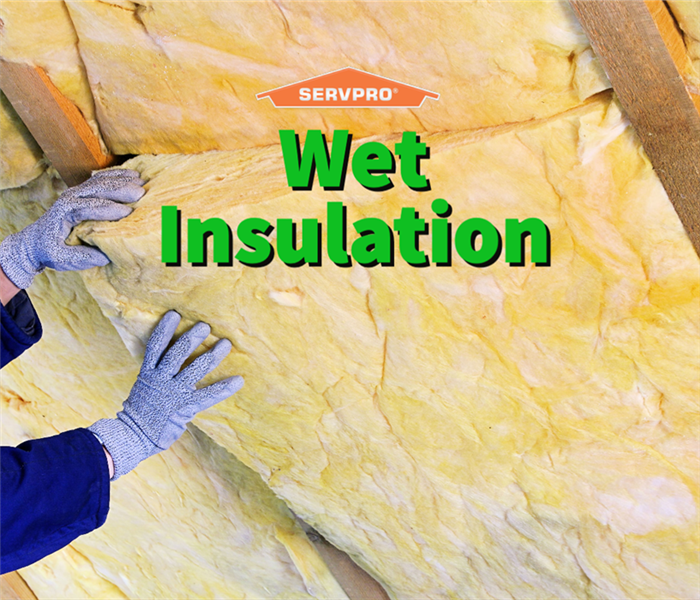 Contact the professionals at SERVPRO for emergency water restoration services!
Contact the professionals at SERVPRO for emergency water restoration services!
Wet insulation can be an issue in terms of the short-term damage it can do to your property and the lasting structural damages it can create.
Like most people, you probably don't think about insulation until it's cold outside and your home is drafty. But did you know that wet insulation is a serious problem that can lead to extensive damage in your home?
The professionals at SERVPRO of Barrow County have mitigated countless water restoration projects and know that wet insulation is a significant issue that requires addressing. Wet insulation can lead to several problems, such as:
- Mold growth
- Structural damage
- Decreased energy efficiency
If you think your home may have wet insulation, knowing the most common signs is essential. This blog post will discuss the five most common symptoms of wet insulation and what you can do about it. Wet insulation can cause a lot of damage to your home, so it is essential to address it as soon as possible.
What is wet insulation?
There are a few things you need to understand when it comes to wet insulation. First off, insulation comes in many different materials and is designed to keep a property warm in the winter and cool in the summer. If your wet insulation is no longer performing this way, it could mean that there is wet insulation inside your wall cavities or attic spaces.
Wet insulation is any insulation that has been wet for an extended period and can be due to several factors, such as:
- Flooding
- Roof leaks
- Pipe bursts
- Condensation
The five most common signs of wet insulation?
If you think your insulation may be wet, knowing the most common signs is essential. Here are the most common symptoms of wet insulation:
- The insulation is wet to the touch.
- There is water damage on the ceiling or walls. Keep a lookout for water spots and discoloration.
- There is a musty smell in the house. The majority of the time, a musty odor comes from the wet insulation in your home.
- There is mold or mildew growth. Mold growth is especially common when wet insulation has been wet for an extended period. You will see mold growing on surfaces, such as walls or ceilings.
- There are dramatic changes in utility bills. If your wet insulation is no longer keeping your home warm or cool, this can cause you to use more energy by trying to maintain a comfortable temperature in your home.
If you notice any of these common signs of wet insulation, it is essential to call a professional water restoration company like SERVPRO of Barrow County right away. The sooner you address the issue, the less damage wet insulation can do to your home.
How can SERVPRO of Barrow County help with wet insulation?
The professionals at SERVPRO of Barrow County have the training and experience necessary to handle any size water damage restoration project. We almost always find wet insulation in nearly every water damage call we receive. When you contact us, we promise to work quickly to mitigate the damage and restore your home to its preloss condition.
All of our professionals have gone through extensive training from the Institute of Inspection, Cleaning, and Restoration Certification (IICRC) and are fully certified to handle wet insulation. In addition, we have been taught the importance of working quickly in addressing the wet insulation in your home.
Whether you are dealing with wet insulation due to flooding, a pipe burst, or any other cause, we are here to help restore your property and get your life back on track. Contact us today! Our team is available 24/7 to help you address the wet insulation in your home.

 24/7 Emergency Service
24/7 Emergency Service









